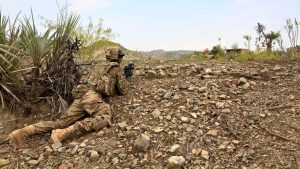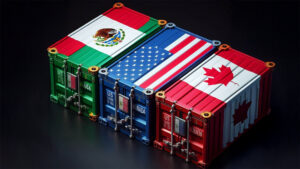Urban violence has been a stable feature of the news and politics mash-up of the past year or so. Whether it’s the murder rate in Chicago, or the threat of immigrants and the call for a southern border wall, or the civilizational threat of Antifa, it seems like there’s a lot out there to be spooked about.
Which makes it kind of odd that we’ve heard so little about Mexican drug violence as of late. The issue would play into hard right talking points regarding immigration, law enforcement, and The Wall™.
But, while there is certainly a lot of violence throughout Mexico still, things have quieted. The decline in violence since its peak in 2011 has been substantial and real – but it is not lasting. Violence is already very much on the rise again and Mexico is on the verge of a much more violent chapter in its drug war.
The story of these fluctuations in violence can all be told through the evolution of the Sinaloa cartel, by far the most active drug trafficking organization (DTO) in terms of smuggling and transporting activities within the United States. The cartel owes it success to a few key pillars:
- Geography: Sinaloa has control over the Golden Triangle, a region in northwestern Mexico between the cities of Chihuahua to the north, Sinaloa on the Pacific coast, and Durango near central Mexico. The golden triangle is one of the few places in Mexico with a climate conducive to growing drug crops on a large scale. While that would be important income stream regardless, the real benefit is that all Mexico’s other DTOs are largely dependent upon transiting drugs from South America. Should something interrupt those supply chains, only the Sinaloa maintains independent sourcing. Meanwhile, the Sinaloa’s position on the coast also gives Sinaloa access to imported chemicals and other ingredients in producing synthetic drugs, which have become extremely important to cartel profits in recent years. In fact, the Sinaloa is in many ways a pioneer in pushing synthetics into the U.S. market.
- Timing: The United States has been surprisingly successful lately in its anti-drug programs. Large-scale, domestic production of meth has all been shut down since a 2005 initiative against precursors. Marijuana began a path to legalization that has shifted a lot of production to the United States and out of the hands of cartels. Legal opioids were attacked head on, shutting down pill-mills and placing heavy restrictions on prescriptions. But this success has been ironically self-defeating. The Sinaloa was quick to take up meth production to fill the gap of lost U.S. production. And while legalization of marijuana certainly hurt the cartels, cutting into the profits of some DTOs by nearly half, it only drove Sinaloa to refocus its energies on local production of heroin.
- Opioids: As a result, cheap heroin has flooded the markets to win back market share even as people in need of pain relief (or a fix) are willing to go to extreme measures to get now-less plentiful opioids. Complicating the picture, the Sinaloa has pioneered putting their heroin and synthetics into pill form and marketing it as counterfeit opioids, earning them a big new market across Middle America. Such heroin/opioid pills are a big reason why U.S. overdose deaths have tripled in recent years.
- Structure and Tactics: The Mexican government began its crackdown on cartels in earnest in the mid-2000s and it has been broadly successful in carrying out a kingpin strategy. But as other cartels found their leaders picked off and their cartels fractured, the Sinaloa Cartel was able to continue uninterrupted due to its cellular structure and strategic use of intelligence. The head of the Sinaloa Cartel, known as El Chapo, was no street corner dealer. He excelled at managing the various factions within his cartel, encouraging them to experiment with new drugs (fentanyl) and new delivery mechanisms (heroin in “opioid” pill form), while discouraging them from engaging in petty crime – better to keep the Mexican government and Mexican population agnostic about Sinaloa activities. He was not afraid to play government forces off his rivals, supplying the government with both strategic and tactical intelligence on the other DTOs. And then there is simple mechanics: Mexico’s DTOs have proven so numerous and tenacious that Mexico City couldn’t possibly fight them all simultaneously. Why fight the Sinaloa if the Sinaloa is making it easier to fight the rest?
- Border connections: By 2008, the Sinaloa Cartel was one of the most important DTOs in Mexico, but they didn’t directly control any of the border plazas. Plazas are not the quant city squares you might be thinking of, but key drug trafficking marketplaces or smuggling points. So the Sinaloa embarked on a campaign against the smaller but still powerful cartels who controlled the plazas of interest along the Northern border, most notably the Tijuana and Juarez cartels. What proceeded was the most violent chapter of the drug war to date as the Sinaloa literally fought in the streets to forcibly assimilate these cartels. It was during this Sinaloa consolidation effort that the city Juarez became the most violent city in the world.
And then, suddenly, the violent murder rate fell just as quickly as it rose.
As the other cartels faced inner-turmoil and a quickly changing market up north, El Chapo’s Sinaloa Cartel thrived and expanded as he gained a reputation for cutting down his allies. By 2014, Sinaloa was the major wholesaler in most American cities and Mexico had come under what came to be known as Pax-Sinaloa over a huge swath of Mexican territory. It wasn’t exactly rainbows and unicorns, but compared to the incredible violence of 2011 and 2012, Mexico was at peace. Juarez became safer than many large U.S. cities because the drugs could now flow without hinderance through the territory of a single (huge) cartel.
And this is the key point: the violence stops when someone wins.

But that victory was short lived. Success in the plazas meant the Sinaloa could easily expand north of the border. By 2015 the Sinaloa was not just the top DTO in the world, but also the top organized crime group in the United States. El Chapo and the Sinaloa quickly became priority number one in the U.S. as opioid deaths rose to epidemic levels. El Chapo still had significant protection in Mexico, but he underestimated American interest in his removal. By 2016 El Chapo had been arrested (and escaped and re-arrested) and extradited to the United States. Bereft their leader’s sophisticated management, the Sinaloa immediately started to break down.
Which brings us to today. As the Sinaloa slides into internecine warfare, other cartels seek pieces of the Sinaloa’s empire; violence is again on the rise. The most important of these was a one-time partner of the Sinaloa known as the Jalisco New Generation Cartel. Based in the southwest, the Jalisco also has important geographic advantages, primarily in their control of the two most important Pacific ports as well as the synthetic drug capital of Mexico, Guadalajara. Their leader – El Mencho – lacks El Chapo’s diplomatic and personal touches. Instead he is more paramilitarily-minded, and more than willing and able to bring heavy equipment and advanced tactics to intimidate and/or eradicate his foes. He has formed alliances with several of the groups that El Chapo once sought to cut down and is continuing to take advantage of shifts in the American drug market. The Jalisco is far more violent than the Sinaloa ever was… and the Sinaloa were f’ing brutal.
The Jalisco started by taking advantage of the collapse of the Gulf Cartel in Mexico’s east, exacerbating the violence between the Gulf’s remnants and that of the Gulf’s former enforcers, the Zetas. Of late the Jalisco has barged into core Sinaloa territory, taking them on throughout the Baja Peninsula (ergo the Cabo violence) and especially the Tijuana border plaza. They are just now starting in on Chihuahua and the Juarez plaza. And within a year – unless the incredibly reclusive El Mencho falls to the kingpin strategy – the Jalisco will likely be in Nuevo Laredo as well.
That would put all the meaningful plazas in the hands of a single group that is arguably the most violent and organized major cartel yet. Even in the unlikely event that the violence does not spill over into the American side of the border, it will be very visible to Americans at a time when American-Mexican relations are already at a generational low.
Just in time for the NAFTA renegotiations to reach a critical point…









